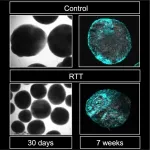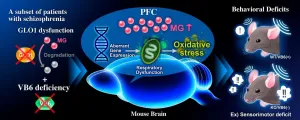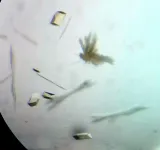(Press-News.org) The muskrat, a stocky brown rodent the size of a Chihuahua - with a tail like a mouse, teeth like a beaver and an exceptional ability to bounce back from rapid die-offs - has lived for thousands of years in one of Earth's largest freshwater deltas, in northeastern Alberta, Canada.
Today, this delta lies within one of the largest swaths of protected land in North America: a national park five times the size of Yellowstone that's home to the planet's biggest herd of free-roaming bison and the last natural nesting ground for the endangered whooping crane. It's also central to the culture and livelihoods of Indigenous peoples, including the Mikisew Cree First Nation, Athabasca Chipewyan First Nation and Métis Local 125.
New research focused on muskrat population dynamics in the Peace-Athabasca Delta, published June 24 in END
Stanford research shows muskrats are a bellwether for a drying delta
2021-07-02
ELSE PRESS RELEASES FROM THIS DATE:
Guadalupe fur seals continue to recover as new colony discovered
2021-07-02
Guadalupe fur seals (Arctocephalus townsendi) have established a large resting colony in the Gulf of California--bringing the total number of sites where this endangered species now occurs to just four. This new haul-out was discovered on El Farallón de San Ignacio Island, along the mainland coast of Mexico, according to researchers from Mexico and the University of British Columbia.
Guadalupe fur seals were hunted for their furs and declared extinct in the late 1800's. However, 14 individuals were discovered on Guadalupe Island in 1950--and the population has grown since then. While still designated as vulnerable to extinction, according to IUCN, the population is believed to total 41,000 individuals and is growing ...
New solution for sleep apnoea
2021-07-02
In an Australian world-first, researchers have successfully repurposed two existing medications to reduce the severity of sleep apnoea in people by at least 30 per cent.
Affecting millions around the world, sleep apnoea is a condition where the upper airway from the back of the nose to the throat closes repetitively during sleep, restricting oxygen intake and causing people to wake as often as 100 times or more per hour.
Those with untreated sleep apnoea are more likely to develop cardiovascular disease, dementia and depression, and are two to four times more likely to crash a car than the general population.
Despite almost thirty years of research, there are no approved drug therapies to treat the condition.
Professor Danny Eckert, Principal ...
Uncovering the genetic mechanism behind Rett syndrome
2021-07-02
Fukuoka, Japan--Medical researchers led by Kyushu University have revealed a possible underlying genetic pathway behind the neurological dysfunction of Rett syndrome. The team found that deficiencies in key genes involved in the pathology triggers neural stem cells to generate less neurons by producing more astrocytes--the brain's maintenance cells.
The researchers hope that the molecular pathology they identified, as reported in the journal Cell Reports, can lead to potential therapeutic targets for Rett syndrome in the future.
Rett syndrome is a progressive neurodevelopmental disorder characterized by impairments in cognition and coordination--with varying severity--and occurs in roughly one in every 10,000 to 15,000 female births. However, it ...
Observation, simulation, and AI join forces to reveal a clear universe
2021-07-02
Japanese astronomers have developed a new artificial intelligence (AI) technique to remove noise in astronomical data due to random variations in galaxy shapes. After extensive training and testing on large mock data created by supercomputer simulations, they then applied this new tool to actual data from Japan's Subaru Telescope and found that the mass distribution derived from using this method is consistent with the currently accepted models of the Universe. This is a powerful new tool for analyzing big data from current and planned astronomy surveys.
Wide area survey data can be used to study the large-scale structure of the Universe through measurements of gravitational lensing patterns. In gravitational lensing, the ...
Novel strategy for natural product biosynthesis
2021-07-02
Microorganisms produce natural products, for example, as disease-causing virulence factors or as defense substances against predators and competitors. A team led by Dr. Robin Teufel and first author Ying Duan from the Institute of Biology II at the Faculty of Biology of the University of Freiburg, together with researchers from the University of Bonn, have now discovered a novel enzyme that is crucial for the production of so-called bacterial tropone natural products. The researchers presented their results in the current issue of the Journal of the American Chemical Society.
Previously unknown enzyme type
Bacteria found in terrestrial and marine environments produce tropone natural products, among other things, when they interact symbiotically with plants, algae or lower animals, for ...
Methylglyoxal detoxification deficits causes schizophrenia-like behavioral abnormalities
2021-07-02
Methylglyoxal (MG) is a highly reactive α-ketoaldehyde formed endogenously as a byproduct of the glycolytic pathway. MG accumulates under conditions of hyperglycemia, impaired glucose metabolism, or oxidative stress. An excess of MG formation causes mitochondrial impairment and reactive oxygen species (ROS) production that further increases oxidative stress. It also leads to the formation of advanced glycation end products (AGEs) due to MG reacting with proteins, DNA, and other biomolecules, which can induce aberrant inflammation via binding to receptors for AGEs (RAGE). To remove the toxic MG, ...
How ethane-consuming archaea pick up their favorite dish
2021-07-02
This insight is the result of the close collaboration of several research groups at the Max Planck Institute for Marine Microbiology. A team around Cedric Hahn and Gunter Wegener recently discovered ethane-degrading microbes at hydrothermal vents of the Guaymas Basin at a water depth of 2,000 meters in the Gulf of California. They named it Ethanoperedens thermophilum, which means "heat-loving ethane-eater". Cedric Hahn a PhD student from the research group Molecular Ecology cultured the ethane-degrading microbes in the laboratory. Hahn, Wegener and colleagues of the research group Microbial Metabolism, Tristan Wagner and Olivier Lemaire took a closer look at these microorganisms. This collaborative work unraveled the secrets behind ...
At what temperature the weather becomes a problem
2021-07-02
"We have studied which temperatures are preferable and which are harmful in humans, cattle, pigs, poultry, and agricultural crops and found that they are surprisingly similar," says Senthold Asseng, Professor of Digital Agriculture at TUM. According to the study, preferable temperatures range from 17 to 24 degrees Celsius.
When does it become too hot for humans?
At high humidity, mild heat strain for humans begins at about 23 degrees Celsius and at low humidity at 27 degrees Celsius. "If people are exposed to temperatures above 32 degrees Celsius at extremely high humidity or above 45 degrees Celsius at extremely low humidity for a lengthy period of time, it can be fatal," says Prof. Asseng. "During extreme heat events with temperatures far above 40 degrees Celsius, such as those ...
The missing ocean plastic sink: Gone with the rivers
2021-07-02
Plastics are a growing problem for natural ecosystems around the globe, and in particular for our marine and freshwater environments. Rivers are the leading source of plastic pollution, as it has been estimated that they deliver several million metric tons of plastic annually to our oceans from poor land-based waste management. The problem is that the estimates made for plastics flowing from the rivers are tens to hundreds of times higher than the quantity of plastics floating on the ocean's surface. So where is all of this river-derived plastic actually going - is there a missing plastic 'sink' somewhere in the ocean? Are the estimates correct?
In a paper published ...
Three-in-one approach boosts the silencing power of CRISPR
2021-07-02
Originally discovered as a bacterial mode of defense against invading viruses, the remarkable ability of CRISPR-Cas9 to modify specific locations of DNA has made it a researcher favorite among gene editing tools. The ongoing effort to explore further possibilities of the CRISPR-Cas9 system is ushering in newer developments to this tool. In one of the latest refinements of the technique, as illustrated in a study published in BioDesign Research, scientists from Stanford University, USA have developed a CRISPR-Cas9 system that induces highly effective silencing of target genes.
The versatility of CRISPR-Cas9 based gene editing is largely ...







